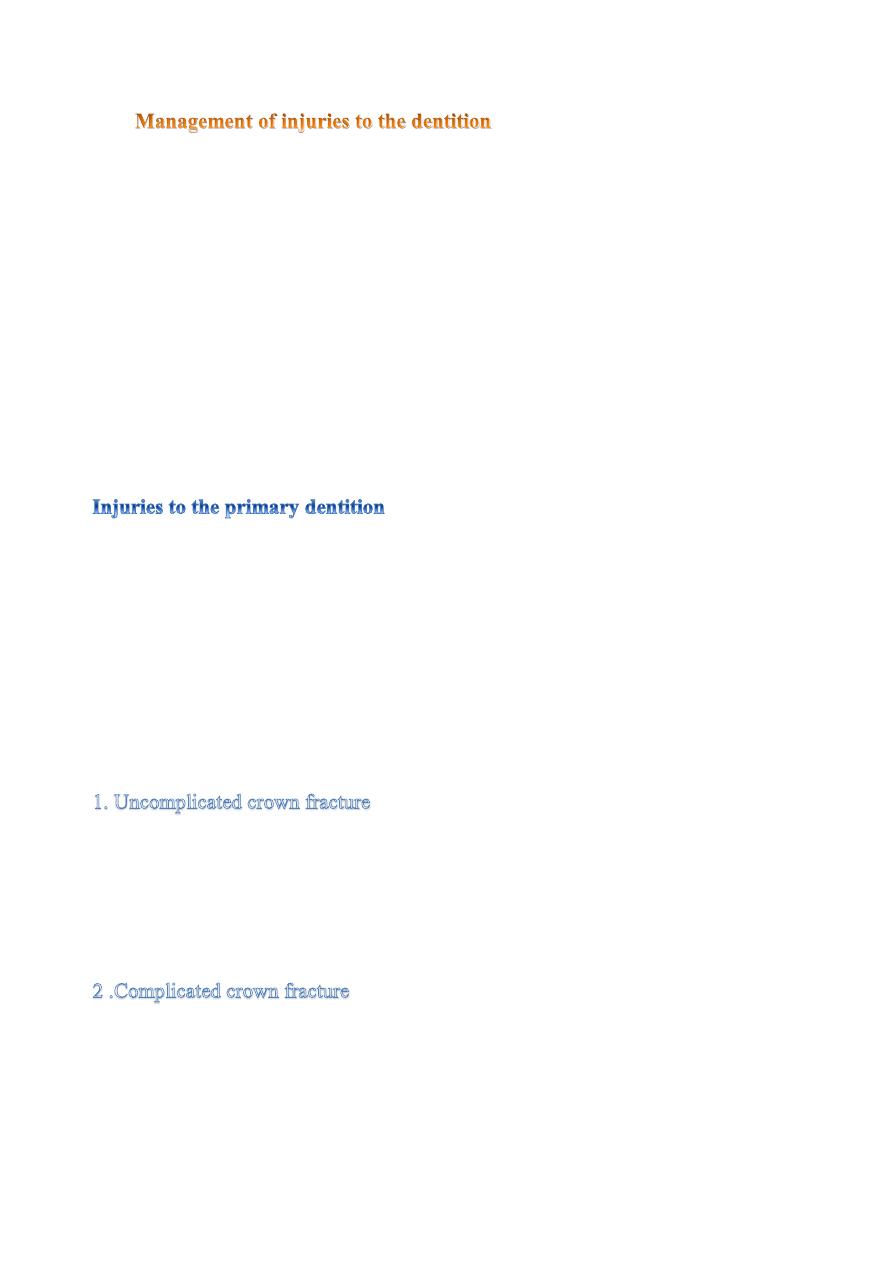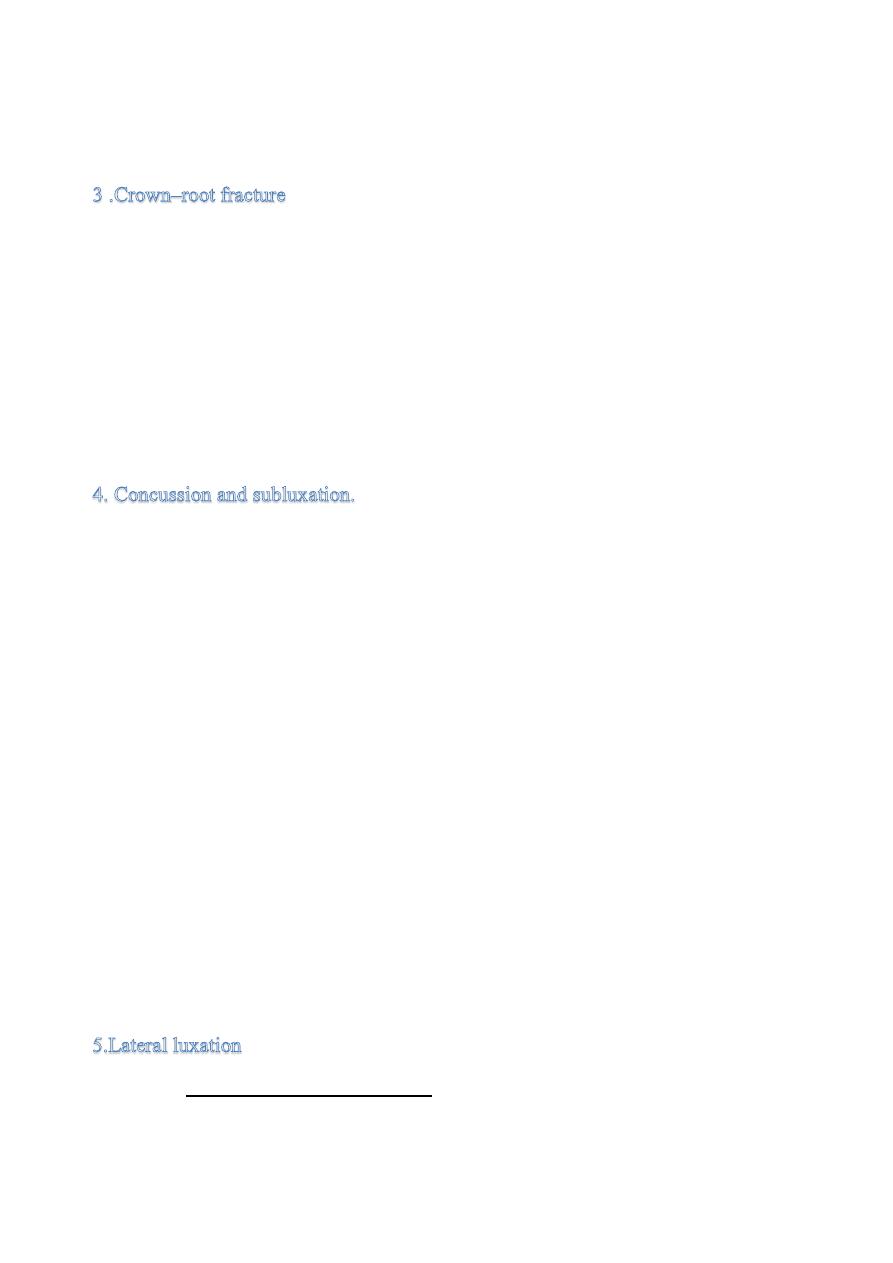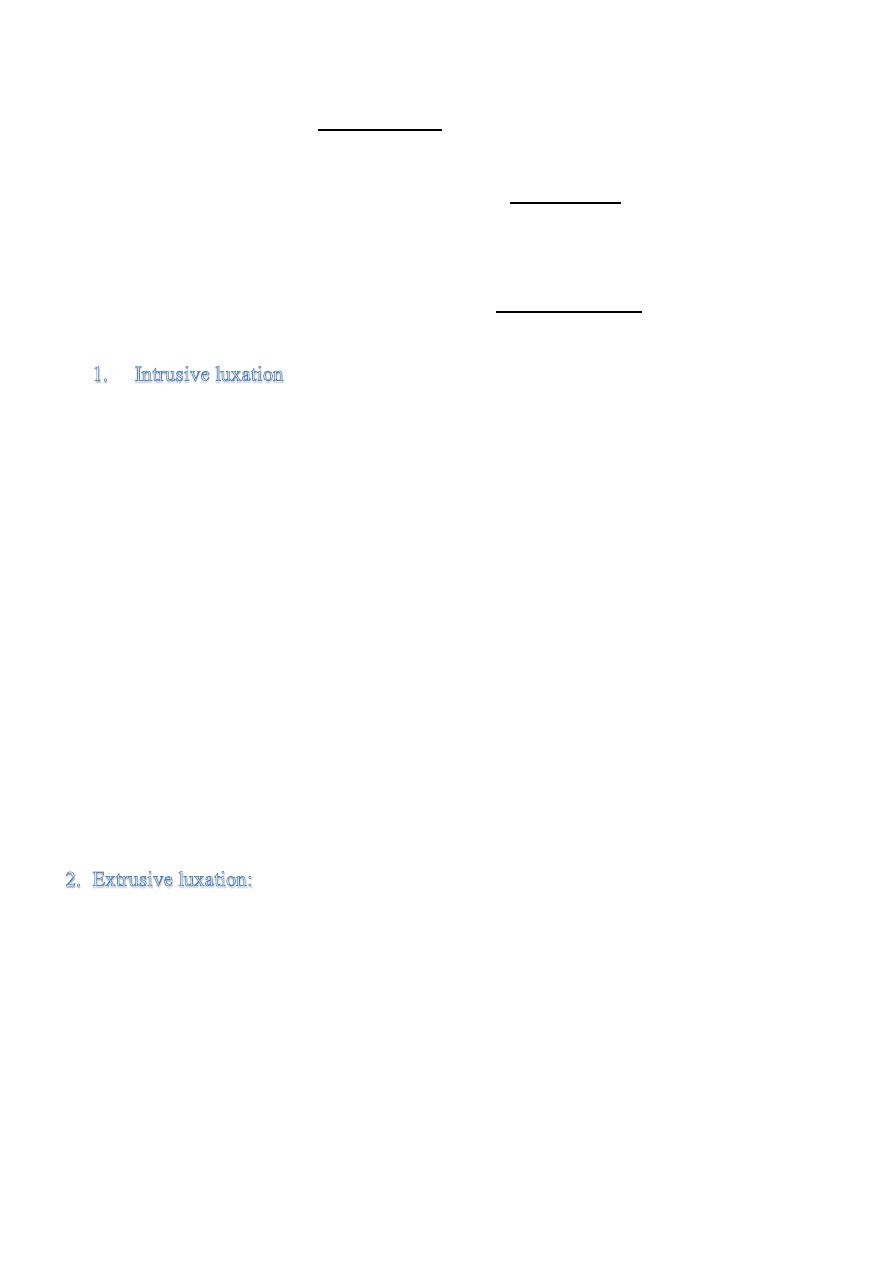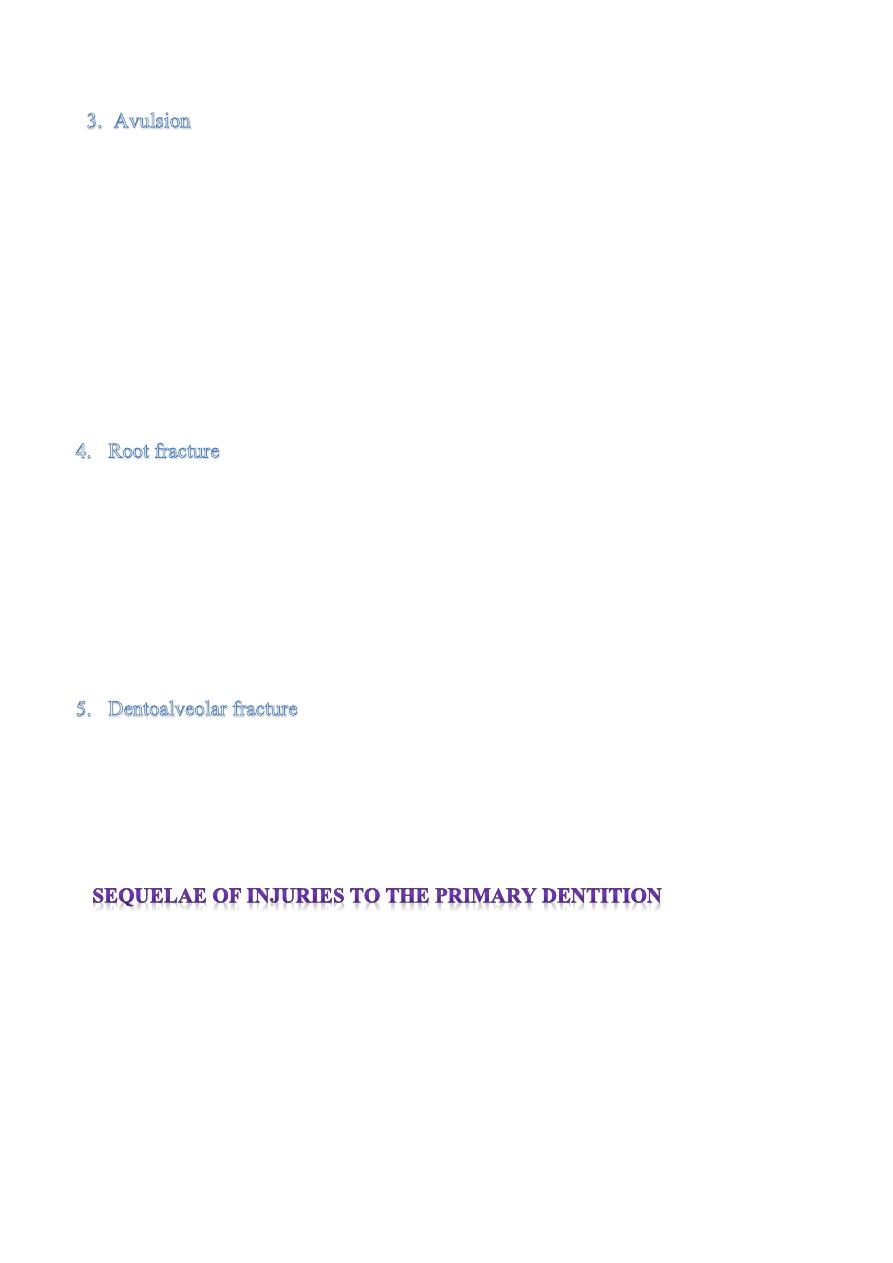
General management consideration:
Immunization: if the child is not fully immunized then a tetanus booster is
required: Tetanus toxoid 0.5 ml by immediate intramuscular injection.
Antibiotics: unless there are significant soft – tissue or dento – alveolar
injuries, antibiotics are not normally required. Antibiotics are prescribed
empirically as a prophylaxis against infection, but are not a substitute for
proper debridement of wounds. All drugs should be prescribed according to
the child’s weight.
During its early development the permanent incisor is located palatally to and
in close proximity with the apex of the primary incisor. With any injury to a
primary tooth, there is risk of damage to the underlying permanent successor.
Most accidents in the primary dentition occur between 2 and 4 years of age.
Realistically, this means that few restorative procedures will be possible and in
the majority of cases the decision is between extraction or maintenance
without performing extensive treatment.
Unlike the permanent dentition, primary teeth are more commonly displaced
rather than fractured. Enamel and dentin may be smoothed with a disk and if
possible cover the dentin with glass – ionomer cement or composite resin if co
–operation is satisfactory.
If the root is in the process of resorbing, the suggested treatment is extraction.
If the pulp tissue is vital, a pulpotomy is performed. Pulp capping is not a
recommended procedure for primary teeth. If the pulp is non vital and the root
structure is intact, a pulpectomy is performed. Follow up treatment consists of

a clinical examination after one week and a radiographic examination at six to
eight weeks and one year intervals.
The pulp is usually exposed and any restorative treatment is very difficult. It is
best to extract the tooth.
If there is no displacement and only a small amount of mobility, the tooth
should be kept under observation. If the coronal fragment becomes non-vital
and symptomatic, it should be removed. The apical portion usually remains
vital and undergoes normal resorption. Similarly, with marked displacement
and mobility only the coronal portion should be removed.
Associated soft tissue damage should be cleaned by the parent twice daily with
0.2% chlorhexidine solution using cotton buds or gauze swabs until it heals.
Concussion is an injury to the tooth and ligament without displacement or
mobility of the tooth and the tooth firm in the socket. Subluxation occurs when
the tooth is mobile but is not displaced. Both involve minor damage to the
periodontal ligament. All these teeth are tender to percussion.
Marked mobility
requires extraction.
Management:
Periapical radiograph as baseline.
Soft diet for 1 - 2 weeks, analgesic and antibiotics and keep the traumatized
area as clean as possible.
Advice to the parents of possible sequelae, such as pulp necrosis.
Individualized follow up.
Treatment Spontaneous repositioning If there is no occlusal interference, as
is often the case in anterior open bites, the tooth should be allowed to

reposition spontaneously. Repositioning When there is occlusal interference
local anesthesia should be applied where after the tooth should be repositioned
by gentle combined labial and palatal pressure. Extraction For teeth with
severe displacement in a labial direction, extraction is the treatment of choice.
Extraction is indicated in these cases because of the collision between the
primary tooth and the permanent tooth germ. Slight grinding In cases with
minor occlusal interference, slight grinding is indicated.
It is common condition injuries to upper primary incisors in children in the
first 3 years because of spongy bone. Falls and striking of teeth on hard object
may force the tooth into the alveolar process to the extent that the entire
clinical crown becomes buried in bone soft tissue.
Management: The aim of investigation is to establish the direction of
displacement by thorough radiographical examination. If the root is displaced
palatally towards the permanent successor then the primary tooth should be
extracted to minimize the possible damage to the developing permanent
successor. If the root is displaced buccally then periodic review to monitor
spontaneous re – eruption should be allowed.. If the tooth exhibits no evidence
of re-eruption after a four week period, extraction of the tooth is recommended
to avoid ankylosis and possible injury to the developing permanent tooth.
Treatment depends on the degree of displacement, occlusal interferences and
time to exfoliation. If the injury is not severe ( less than 3mm extrusion), the
tooth may be repositioned or allowed to spontaneously align. When the injury
is severe, the tooth is nearing exfoliation, or the patient is uncooperative,
extraction should be considered.

Replantation of avulsed primary incisors is not recommended due to the risk of
damage to the permanent tooth germs. The other main reason is lack of patient
cooperation, and most of such injuries occur at age when it would be difficult
to construct a splint or appliance to stabilize the repositioned tooth. Space
maintainer is not necessary immediately following the loss of a primary incisor
as only minor drifting of adjacent teeth occurs. The eruption of the permanent
successor may be delayed for about 1 year as a result of abnormal thickening
of connective tissue overlying the tooth germ.
If the tooth is stable and causing no discomfort to the patient, the tooth needs
only to be monitored by clinical and radiographic examination post trauma. If
the tooth is mobile and the patient expresses discomfort, the coronal fragment
should be extracted. If the apical fragment is too difficult to retrieve, it should
be left to resorb so as not to disturb the developing permanent tooth. The
tooth is monitored for apical pathology or normal resorption
This is more common in the mandible with the anterior teeth displaced
anteriorly with the labial plate. It is often desirable to reposition the teeth with
the bone to maintain the alveolar contour. this can be achieved with thick
nylon suture passed through the labial and lingual plates of the bone.
Complications following traumatic injuries to primary teeth may appear
shortly after the injury (e.g., infection of the PDL or dark discoloration of the
crown) or after several months (e.g., yellow discoloration of the crown and
external root resorption).
Pulpitis

The pulp's initial response to trauma is pulpitis. Capillaries in the tooth
become congested, Teeth with reversible pulpitis may be tender to percussion
if the PDL is inflamed (e.g., following a luxation injury). Pulpitis may be
totally reversible if the condition causing it is addressed, or it may progress to
an irreversible state with necrosis of the pulp.
Infection of the Periodontal Ligament
Infection of the PDL becomes possible when detachment of the gingival fibers
from the tooth in a luxation injury allows invasion of microorganisms from the
oral cavity along the root to infect the PDL. Loss of alveolar bone support can
be seen on a periapical radiograph . This diminishes the healing potential of
the supporting tissues. Subsequently, increased tooth mobility accompanied by
exudation of pus from the gingival crevice will require extraction of the
injured tooth.
Pulp Necrosis and Infection
Two main mechanisms can explain how the pulp of injured primary teeth
becomes necrotic: (1) infection of the pulp in cases of untreated crown fracture
with pulp exposure, and (2) interrupted blood supply to the pulp through the
apex in cases of luxation injury leading to ischemia. Periapical radiolucencies
indicative of a granuloma or cyst are frequently evident radiographically in
necrotic anterior teeth.



